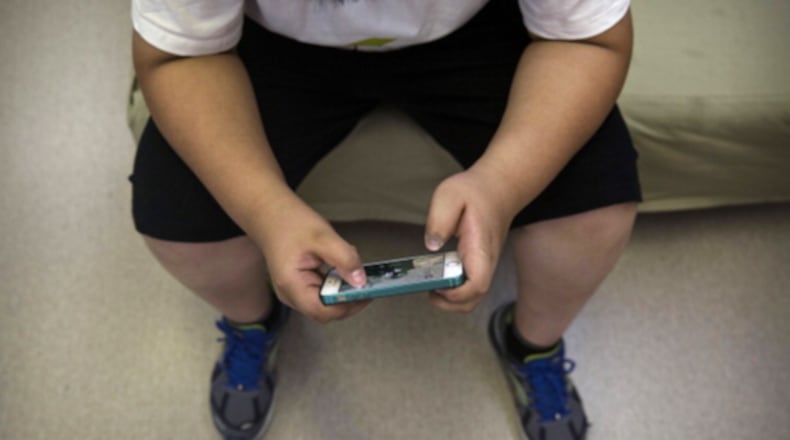“They’re all on a computer doing the schoolwork or playing games so they’re more sedentary, and all of that is just going to increase the weight for children,” said Marquetta Colbert, nurse practitioner and owner of Colbert Family Health and Wellness in Trotwood.
Obesity at any age puts people at risk for heart disease, diabetes, high blood pressure and asthma, which are all underlying health issues that make contracting COVID-19 easier and beating it that much harder.
Colbert said although the death rate is lower for children COVID-19, weight has played a factor in children that have died due to the virus.
Child obesity is described as children and adolescents who are over the standard weight for their height and age range. In Ohio, 15.7% of children between the ages of 10 and 17 were considered obese, according to a 2018-2019 study by the National Survey of Children’s Health.
“Childhood obesity remains an epidemic in this country,” said Jamie Bussel of the Robert Wood Johnson Foundation, which funds the National Survey of Children’s Health.
Ohio did see a slight decrease in the percentage of obese children from 17.1% between 2016-2017 and the 15.7% in 2018-2019, but the pandemic may have reversed the state’s progress.
“During the time of the pandemic, I think it made it worse and I think it increased the numbers of obesity. I think when the pandemic is over, we will have to work harder to get back to what little bit of gains that we did have,” Colbert said.
Causes of child obesity
University of Dayton assistant professor of nutrition Diana Cuy Castellanos said socioeconomic and environmental factors are contributors to child obesity.
“We can connect obesity to what neighborhoods our kids are living in, what kind of food access they have, and then also within their own environment like within their household,” she said.
Research from the Centers for Disease Control shows racial and ethnic disparities are present in obese children. Cuy Castellanos said Black and Hispanic children have higher rates of obesity than white children. This includes non-Hispanic Asian children.
Those living in low income households are more likely to live in food deserts and experience food insecurity.
Food insecurity, the inability to access healthy and affordable foods, impacted more than 13.6 million households in 2019, according to a study by the U.S. Department of Agriculture Economic Research Service. Families without means to pay for healthier food, or ability to get to a grocery store with healthy food options are more likely to eat unhealthily.
“By not having those grocery stores that have healthy food choices, they are more likely to pick high calorie dense foods, sugary foods, because they’re going to get what’s close buy. Even if they’re going to discounted stores, they are going to purchase the foods that are available,” Colbert said.
West Dayton is classified as a food desert as the area continues to lose grocery stores. Those in the area must travel more than seven miles to get to the nearest store with adequate food options.
Children are also impacted by their neighborhood which can limit their physical activity and lead to obesity or weight gain. Cuy Castellanos said she’s encountered kids that can’t play outside and have physical activity because their neighborhood isn’t safe.
“They told me I can’t go outside because there’s a child molester that lives down the street from me or we hear gunshots all the time so we can only play right here,” she said.
Solutions to prevent child obesity
Colbert said while there are factors that families can’t control like genetics, families should focus on changing things they can control including limiting screen time, increased physical activity and educating themselves about healthier choices and lifestyles.
Children are dependent on their parents and what food they bring home is what is made available for them to eat.
“In order to really make an impact in the children, the parents have to be educated and the parents have to be willing to adopt the lifestyle as well,” Colbert said.
Recently, Dayton received a $50,000 grant from the U.S Conference of Mayors and the American Beverage Foundation for a Healthy America to fund programs at summer camps that teach and promote healthy eating lifestyles.
The program, Dayton Sprouts, will give campers age six to 17 booklets and weekly themes about how to achieve and sustain healthy eating habits. The materials will be available online for families that don’t have children in summer camps.
Cuy Castellanos is hopeful that the numbers will continue to trend downwards and lead to fewer children suffering from obesity.
In its report, the Princeton, New Jersey-based Robert Wood Johnson Foundation outlines several policy recommendations for combatting childhood obesity.
Bussel encourages parents to establish routines for their children, even while learning remotely. Kids should have a set time bedtime and wakeup time, as well as scheduled times for learning, lunch and outdoor activity.
Kids can pack a healthy lunch the night before school, even if they’re just eating it at home, she said.
Families who are able could also use food banks or pantries to secure staple items, such as bread and cereal, and save their money for other items at the store, she said.
Parents of kids of all ages should model healthy behavior, she said.
And if a child has obesity, it’s not a foregone conclusion he or she will always be obese. Caregivers should talk with their child’s doctor about the child’s growth and how to slowly implement healthy changes. Kids who need extra help can be referred to a specialist.
About the Author

